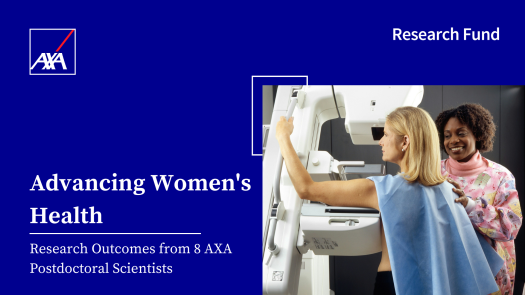Women's Health
Post-Doctoral Fellowships
Switzerland
A promising new strategy to treat osteoporosis
Osteoporosis, a debilitating bone condition that leads to loss in bone density and bone weakening, is expected to affect one in three women worldwide over the age of 50 (1). This burden is likely to increase as the world’s population ages. Menopause, with the decrease in oestrogen that it entails, plays a major role in the onset of this disorder. While oestrogen replacement therapy can help, it does, unfortunately, have many adverse side effects, including an increased risk for breast cancer.
Biologist Alessia Perino of the EPFL in Switzerland, AXA Research Fund Women Health Fellowship Grantee, has thus been looking into alternative and safer treatments, and into the role of bile acids in breaking down old bone and generating new bone in its place. These acids are steroid molecules produced by the liver and are end products of cholesterol metabolism.
The project was initiated by her colleague Laura Velazquez.
Bile acids are known for their fat-emulsifying functions in the intestine, where they are secreted after eating. We now know that bile acids are also hormones and are secreted into the systemic circulation, too. They can thus reach every tissue in the body, including bone.
Dr. Perino, a senior scientist in Prof. Schoonjans’s laboratory, has conducted several studies on how these acids regulate metabolism and found that they are essential to maintaining the body’s energy balance. They do this by activating fat burning in adipose tissue and reducing our desire for food by modulating neural networks in the brain. All these beneficial effects are mediated by a specific bile acid receptor, known as TGR5, which now appears also necessary for bone remodelling.
Bone was long considered merely a structural scaffold for our bodies, but researchers now know that it is a metabolic and endocrine organ in its own right. Dr. Perino therefore decided to study how bile acid-TGR5 signalling impacts bone disorders in experiments on mice. These rodents are essential for this research as there is not in vitro model yet that can recapitulate the complexity of osteoporosis.
They discovered that mice lacking normal TGR5 function have a significantly lower bone mass and show all the signs of osteoporosis. They also have abnormal haematopoiesis (the process in which blood cells are continuously formed and renewed).
The results show a link between bone and haematopoiesis and suggests that targeting TGR5 could improve haematopoiesis by modulating bile acid-TGR5 signalling. The work could therefore help develop new therapeutics for patients with osteoporosis once the molecular mechanisms underlying the observed effects have been understood.
Could the solution to osteoporosis be in the bile ?
Discover an article about Laura's project
Read the Article
Women's Health Fellowhip: Outcome Summary
The following article summarizes all outcomes from 8 postdoctoral research projects from the Women's Helath Fellowship.
Read More
Related articles
Women's Health
AXA Chair
Spain
Understanding Menopause's Effect on Women's Cardiovascular Risk
Cardiovascular disease (CVD) is the leading cause of mortality for women worldwide, yet women remain understudied. Atherosclerosis, the main pathology underlying... Read more
.thumbnail.jpg)
Inés
PINEDA-TORRA
University of Seville
Mental Health & Neurology
Women's Health
Pandemics & Infectious Diseases
AXA Award
Spain
The Effects of the COVID-19 Pandemic on the Mental Health of Mothers and Newborns
Early results are expected in less than 12 months and will help bridge a critical gap in research. Indeed, “in... Read more

Maria
FORASTER
ISGlobal Barcelona Institute for Global Health
Women's Health
Healthcare Systems & Access
Post-Doctoral Fellowship
United Kingdom
Towards timely and quality access to emergency obstetric care in Sub-Saharan Africa
Nearly 300 000 women (1) lose their lives each year from pregnancy-related complications, such as haemorrhage, high blood pressure, obstructed... Read more

Aduragbemi
BANKE-THOMAS
